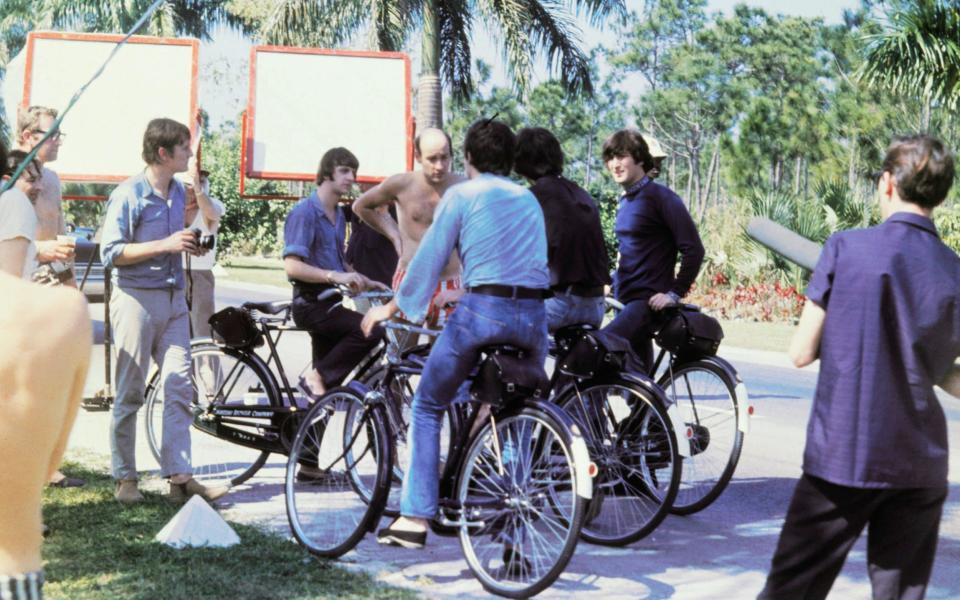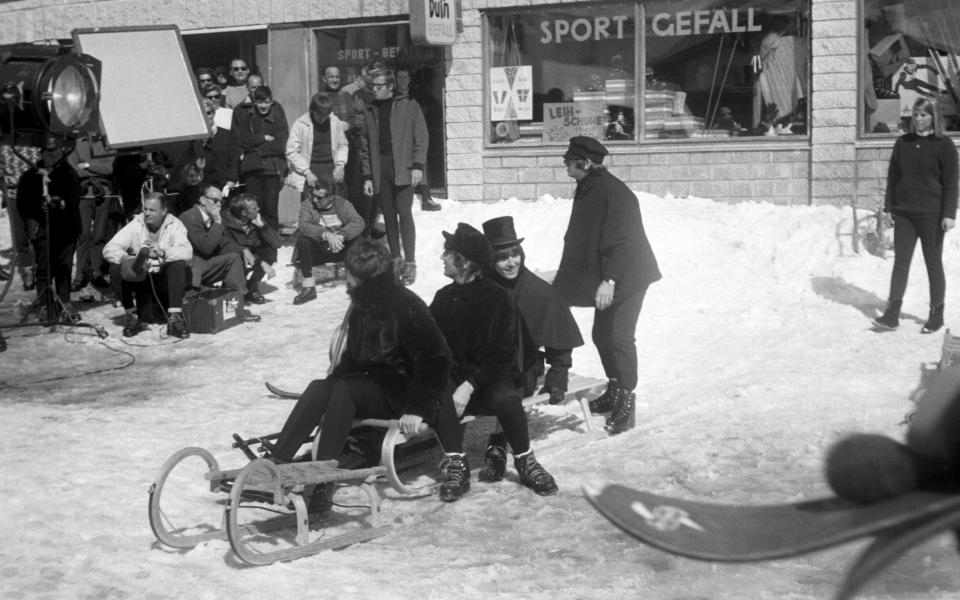The Beatles in Middle-earth? The Fab Four’s bizarre quest to star in The Lord of the Rings

You’d have thought it near impossible to say no to the Fab Four, but JRR Tolkien was having none of their charm.
By the mid-1960s, The Beatles had already starred in two films, A Hard Day’s Night and Help!, and John Lennon had a dream role in mind: Gollum, in The Lord of the Rings. The band and producer Walter Shenson considered a number of alternative ideas for a third film, which included The Beatles in the Army and The Beatles Meet Elvis Presley, but Lennon wanted Smeagol. He also envisaged that Paul McCartney and Ringo Starr might play Frodo and Sam, and George Harrison could be Gandalf.
“We talked about it for quite a while,” McCartney says in Roy Carr’s 1996 book Beatles at the Movies, while Stanley Kubrick’s personal assistant Leon Vitali has told of how the band, led by Lennon, came to the legendary director’s office to discuss his participation.
“They came to Stanley’s office to talk about it,” Vitali told Metro US in May 2018. “I don’t think it was quite in Stanley Kubrick’s ballpark, that idea – it didn’t get very far at all. [There] was an exchange of information, and people were interested in doing it. But Stanley wasn’t. Let’s put it that way.”
McCartney added that the band couldn’t agree on the division of roles, especially since “the strength of the other films” had been that they were “equal”. But it wasn’t until Tolkien – who, in one of his 1964 letters to Christopher Bretherton, complained about the noise of aspiring “Beatle Groups” near his house in Oxford – refused to sell them the rights that Lennon admitted defeat.
Perhaps Kubrick and Tolkien also knew about the band’s nightmarish reputation on set. Their first film, A Hard Day’s Night, had been smooth sailing; a comedy in which Ringo goes missing, directed by Richard Lester, it grossed over 50 times its £200,000 budget and is now regarded as one of the greatest British films of all.
Their second film, however, Help! – also directed by Lester – was not. Released just over a year later in 1965, it focused on an Eastern cult who have to steal a ring stuck to Ringo’s finger in order to complete a ritual killing. It was filmed while the Fab Four were almost perpetually high.
“It is clearly their marijuana period,” the Beatles historian Kenneth Womack tells me over Zoom. “This is when George Martin would notice that they’d go off giggling all of the time.”
Lennon told Playboy of the shoot: “We were smoking marijuana for breakfast during that period. Nobody could communicate with us because it was all glazed eyes and giggling all the time.”
“A hell of a lot of pot was being smoked while we were making the film,” Ringo added in The Beatles Anthology. “That helped make [the shoot] a lot of fun. If you look at pictures of us, you can see a lot of red-eyed shots – they were red from the dope we were smoking.”
Mornings, the drummer continued, were the only time he could shoot the band. “Dick Lester knew that very little would get done after lunch,” he said. “In the afternoon we very seldom got past the first line of the script. We had such hysterics that no one could do anything.”
The band were often drinking the night before shoots, too. When Ringo was praised on his melancholy acting in one scene, he admitted: “It was the result of a massive hangover. Because I’d been drinking all night I was incapable of saying a line.”

In Carr’s book, Lennon even goes as far as to call Help! a “drag”, as they “didn’t know what was happening” and they felt like extras in their own film. Elsewhere in its pages, Lester adds: “It was because they were put up against professional actors, who were saying these bizarre lines better than they did.
“The Beatles made no real attempt at them because they were stoned throughout and probably thought, ‘Oh, sod this.’ The novelty of being around a film crew had obviously worn off and pot was there to alleviate the boredom of hanging around between takes.”
Even though it was only their second film, in many ways Help! marked the beginning of the end for The Beatles’ relationship with the silver screen. Conversations over the potential third Beatles film had soon become strained.
But at the end of 1966, Shenson and The Beatles finally seemed to have made a decision: Shades of a Personality. This would have seen either Ringo or John suffering from a three-way split personality, with the remaining Beatles playing the other personalities. Michelangelo Antonioni, fresh from the success of 1966’s Blow-Up, was linked to directing it, and Joe Orton, who had provoked controversy on the West End with The Ruffian on the Stairs, Loot and Entertaining Mr Sloane, would write it.
Orton wrote in his diary that the script included the Fab Four being “caught in flagrante” as well as dabbling in “dubious political activity”. They’d have also “dressed as women, committed murder, been put in prison and committed adultery”. Epstein, who was still in control of the band’s image at the time, was so dismissive of the script that he didn’t even provide a reason for rejecting it after Orton sent the first draft in February 1967. (Tragically, by August of that same year, both Orton and Epstein would be dead: Orton murdered by his lover and writing partner, Epstein from an accidental drug overdose.)

The Beatles decided to finally make their third film, Magical Mystery Tour, themselves, with Paul McCartney leading the surreal comedy. But it didn’t even make the big-screen; instead, it was broadcast on BBC One in black-and-white on Boxing Day – to a critical thrashing.
“It was their first failure,” says Womack. “And maybe even their only real failure. It was a disaster, to all intents and purposes. They just assumed, because everything else they’d touched had turned to gold, that this would too. McCartney, in particular, thought that their talent could be exported to other areas, like making a film and being a director.
He adds: “It’s a great lesson for all of us. Just because you can do one thing, and you’re the best in the world, doesn't mean you can do everything.”
By this point, The Beatles’ interest in movies had waned to such an extent that their involvement in Yellow Submarine, which was released in July 1968, was minimal. While McCartney originally held talks about making a feature-length animation based on the Revolver song, he wanted it to be more like a Disney movie. Instead, King Features Syndicate wanted to make it psychedelic. The Beatles had no interest, so their voices were provided by actors instead, although the band appeared for a live-action cameo right at the end to fulfill their contractual obligations.

The studio’s vision worked, too, as Yellow Submarine is regarded as a landmark of the animation genre, and now rivals A Hard Day’s Night as The Beatles’ most endearing film. In 1980, just a few weeks before his murder, John Lennon even called it his favourite Beatles movie. Especially since, at the time, he was able to see it through the eyes of his five-year-old son, Sean.
The mainstream appeal of Yellow Submarine came at the perfect time for the band. “When it came out,” says Womack, “they were now the long-haired guys who’d said that they’d taken LSD. In 1968, they were going to put out the White Album with Revolution 9 on it. John was going to release a solo album where he was naked on the cover.
“So isn’t it wonderful that Yellow Submarine provided this counter balance. They could have been raked over the coals for being the counterculture – but, instead, they still got to enjoy the countercultural image while having this movie consumed widely… That kind of demographic sweep is incredible. The films have a lot to do with it.”
Let It Be, The Beatles’ final film about the recording of the album of the same name, might have landed the group the 1971 Academy Award for Best Original Song Score, but it failed to add much to their cinematic legacy. Instead, A Hard Day’s Night, Yellow Submarine, Help!, and even Magical Mystery Tour, which has also developed a cult following in the years since its release, sum up their ever-changing style and artistry in this staggering four year-period.
And they accomplished all that while changing the face of popular music. Imagine what they would have done if Lennon had played Smeagol, too.

 Yahoo News
Yahoo News 
